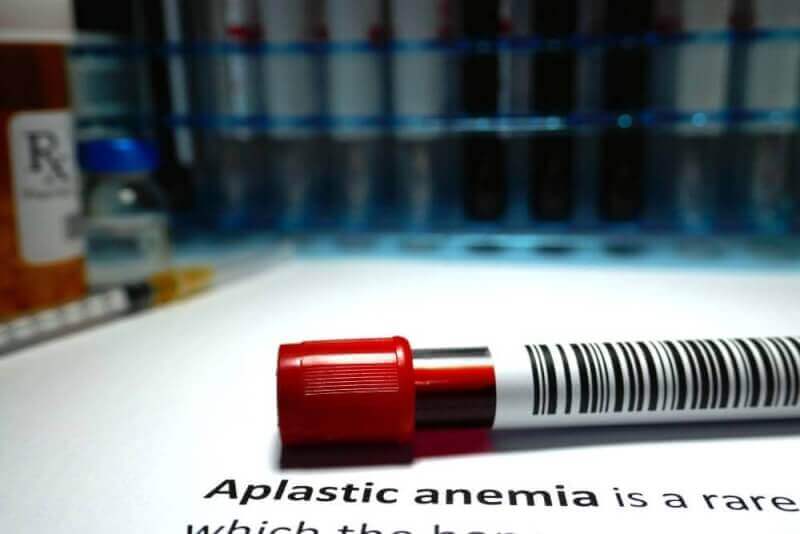What is aplastic anemia?
Aplastic anemia, a disease that affects people of all ages, is more common in Asia. In the United States, it affects 3 out of every 1 million people, while in East Asia it affects 15 out of every 1 million people.
Blood cells are produced by the bone marrow. The bone marrow produces red and white blood cells as well as platelets, which help to control bleeding. The lifespan of each blood cell produced is fixed. For this reason, blood cells need to be constantly produced. However, when it comes to aplastic anemia, the production of all types of blood cells is not enough. In some severe cases, the bone marrow stops producing blood altogether.
Causes of aplastic anemia
The causes of aplastic anemia are not fully known. However, in approximately 20% of patients it is caused by an inherited disorder. The most common is Fanconi anemia.
Aplastic anemia is also seen in people exposed to high doses of radiation. Other factors that cause aplastic anemia include certain chemicals and viruses. The most common cause of aplastic anemia is autoimmune causes. In patients with aplastic anemia, the immune system attacks bone marrow cells.
How is aplastic anemia diagnosed? (Test)
For aplastic anemia to be diagnosed, the patient’s bone marrow must be examined. Aplastic anemia is characterized by low numbers of all blood cells. Bone marrow examination is performed in two different ways.
In bone marrow aspiration, a small amount of fluid is removed from the bone marrow with a needle. Another method used in aplastic anemia is bone marrow biopsy. In a biopsy, a small sample of bone marrow is taken. Both aspiration and biopsy samples are taken from the posterior part of the hip bone.
In both methods, the amount of blood cells is checked. If all three types of blood cells are low, we talk about aplastic anemia. In aplastic anemia, patients have healthy blood cells. The volume of the cell count also plays a role in determining the severity of the disease.
Aplastic anemia is categorized as moderate, severe and very severe. Patients with moderate aplastic anemia can develop into severe aplastic anemia over time. For this reason, the disease needs to be monitored continuously.
Symptoms of aplastic anemia
The symptoms of aplastic anemia are caused by a low blood cell count. For this reason, the severity of the symptoms seen in patients varies according to the number of blood cells.
- Low red blood cell count in patients causes them to feel weak and tired.
- The low white blood cell count in the patient causes patients to experience frequent infections.
- A low platelet count causes redness under the skin, easy bleeding, difficulty in stopping bleeding and red spots.
In patients with moderate aplastic anemia, the symptoms are of moderate or mild severity. However, in patients with severe aplastic anemia, infections and bleeding are serious enough to be life-threatening.
Treatment of aplastic anemia
There are 2 different treatment methods for aplastic anemia. Patients can also take part in various clinical trials. However, approved treatments include immunosuppression and bone marrow transplantation. The survival rate is similar in both treatment methods. Therefore, the choice between treatment options is based on the characteristics of the patient and the potential risks of the treatments.
Bone marrow or cord blood transplantation
The first standard treatment of choice for patients with very severe aplastic anemia is transplantation. In transplantation, the abnormal bone marrow cells in the patient are replaced with bone marrow cells from the donor that can produce healthy blood.
It is especially recommended for patients younger than 20 years of age and for patients with tissue-matched siblings. It is also recommended for patients between the ages of 20 and 40 who have a sibling with tissue compatibility. Treatment of aplastic anemia is usually started with immunosuppressive drugs. However, in advanced stages, if patients do not respond to treatment, transplantation becomes an option. Even if transplantation is planned as the first treatment option, immunosuppressive drugs can be used until the transplantation procedure takes place.
Transplantation for the treatment of aplastic anemia can carry serious risks. However, the development of transplantation operations and the knowledge of the risks that may occur afterwards make the operations much more successful and prevent complications in the subsequent process.
The most important complication that can occur after bone marrow or cord blood transplantation is graft rejection or graft failure. It is especially seen in patients who have had too many blood transfusions before transplantation. For this reason, patients who are considering bone marrow transplantation are prevented from receiving too many blood transfusions before the operation. If blood transfusions are necessary, radiotherapy is used to remove the white blood cells. These applications ensure more successful results of bone marrow transplantation. Mild and moderate complications of bone marrow or cord blood transplantation include patient rejection of the tissue.
Immunosuppressive therapy
Immunosuppressive therapy is one of the standard treatments for patients with aplastic anemia, including those with severe aplastic anemia, which prolongs their life expectancy. Among the conditions that must be met in patients for immunosuppressive therapy to be administered are the following.
- Be over 40 years of age. Definitive advice should be given by doctors and other necessary conditions.
- Inability to carry out the transfer due to old age or other health problems
- Lack of suitable revolving funds for transfer
- Waiting in line for a transfer,
- Those who decide on immunosuppressive therapy after evaluating all treatment options
Immunosuppressive therapy suppresses the immune system. The reason for this treatment is the theory that the immune system attacks the bone marrow. Weakening the immune system therefore leads to more blood cells being produced. Thanks to the treatment, the vast majority of patients have normal or near-normal blood cell counts. This prolongs the life expectancy of patients.
Immunosuppression therapy also has some short-term risks. However, patients should not abandon treatment because of these risks. In the long term, immunosuppression therapy can cause a second disease such as MSD or leukemia.
Supportive treatment
As aplastic anemia worsens, treatment needs to change. Supportive therapies include blood transfusions, prevention of infections and growth factors. Supportive treatment options help to manage symptoms, not cure the disease.
It is also used to control symptoms in patients who are elderly or whose general health cannot tolerate other treatments. Supportive therapies, which do not have any effect on controlling the disease in the long term, improve the quality of life of patients.
Blood transfusion
Especially patients with severe aplastic anemia need blood transfusions from time to time. The goals of blood transfusion are as follows.
- Platelet transplantation reduces the risk of life-threatening bleeding.
- Red blood cell transplants are used to relieve symptoms such as breathlessness and extreme fatigue.
- Red blood cell transplantation helps to reduce the amount of iron accumulated in the body. This is because the accumulation of iron in patients’ bodies causes damage to their organs.
- In addition, blood transfusions reduce the risk of antibody cells attacking platelets.
Before the blood transfusion, the transfused blood is also irradiated with radiotherapy and the red blood cells are filtered. These changes to the blood also reduce the risk of the immune system reacting. It will also reduce other complications.
Growth factors
Growth factors, one of the supportive therapies used in aplastic anemia, are a group of drugs. Thanks to growth factors, patients need fewer red blood cell transplants. However, in a significant proportion of patients with aplastic anemia, the bone marrow does not respond to growth factors. Growth factors are therefore prescribed to patients after immunosuppressive therapy or blood transfusions. In this way, it promotes the production of new blood cells and reduces the risk of infection.
Infection prevention
Patients with severe aplastic anemia are vulnerable to potentially life-threatening infections. These infections are often simple infections such as the common cold. People with aplastic anemia should therefore protect themselves from any risk of infection. For this, patients should especially protect themselves from crowds and patients.
If patients show signs of infection, treatment should be provided as soon as possible. Antibiotics are often used for this.









